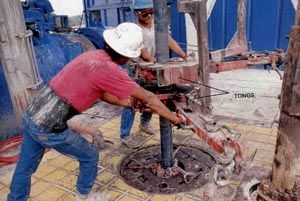Exposure to Rotating Parts
Exposure to rotating parts on an oil rig is a daily occurrence. All rotating equipment parts have inherent dangers. Even slowly rotating equipment can grip material it contacts. Where there are protrusions, the potential for catching increases and the traveling motion of a rotating piece of equipment is a cause for yet greater vigilance.

In addition to rotating the drill string and bit, the rotary table provides for free vertical motion of the drill as the bit penetrates into the earth. Torque is transmitted from the rotary table to the drill by the kelly, which also conveys the drilling mud that is pumped into it through a swivel connector.
A typical drill string consists of 30-foot sections of drill pipe, male and female threaded, that weigh between 14 and 18 pounds/foot (500 pounds/joint). Several heavy, thick-walled joints of pipe, called drill collars, are made up in the drill stem, just above the bit, so the bit will penetrate into the formation being drilled. A single drill collar can weigh between 2,500 and 4,000 pounds (or more) depending on its diameter.
Employee exposure to rotating parts during drilling makes this operation one with a high potential for severe injuries, although the frequency of occurrence is low. The rotary table and kelly bushing are in nearly continuous motion and are not usually provided with any guarding mechanism. Contact with either is likely to cause slips, falls, and bruising accidents; also, there is a risk of being caught between stationary and rotating parts.
Knowledge Check Choose the best answer for the question.
4-8. Which of the following accident types is NOT discussed as being associated with work around the rotary table and kelly bushing?
You forgot to answer the question!
